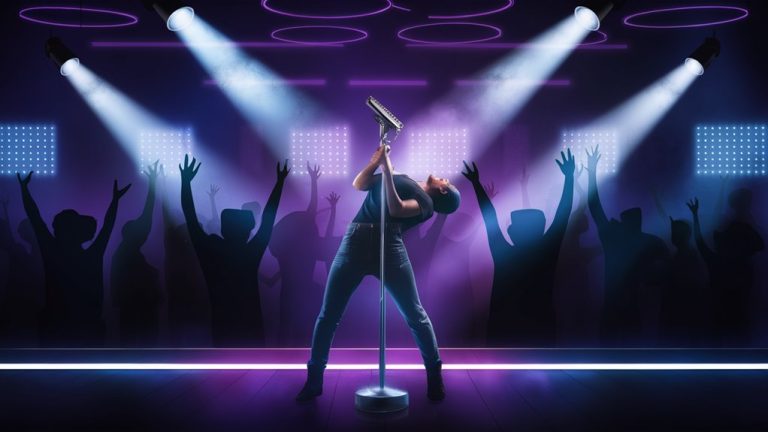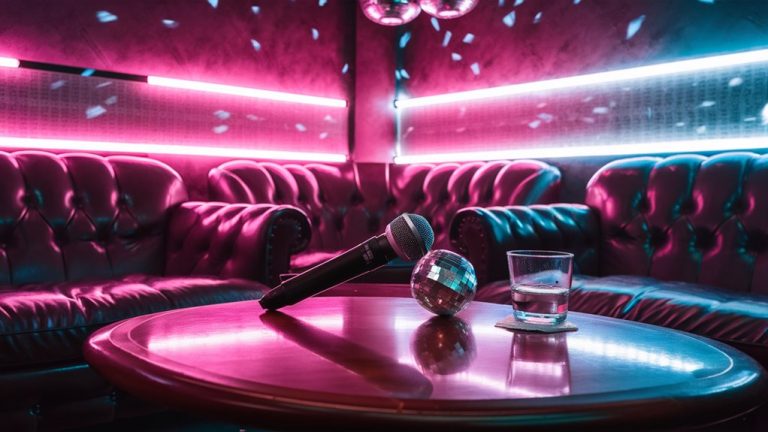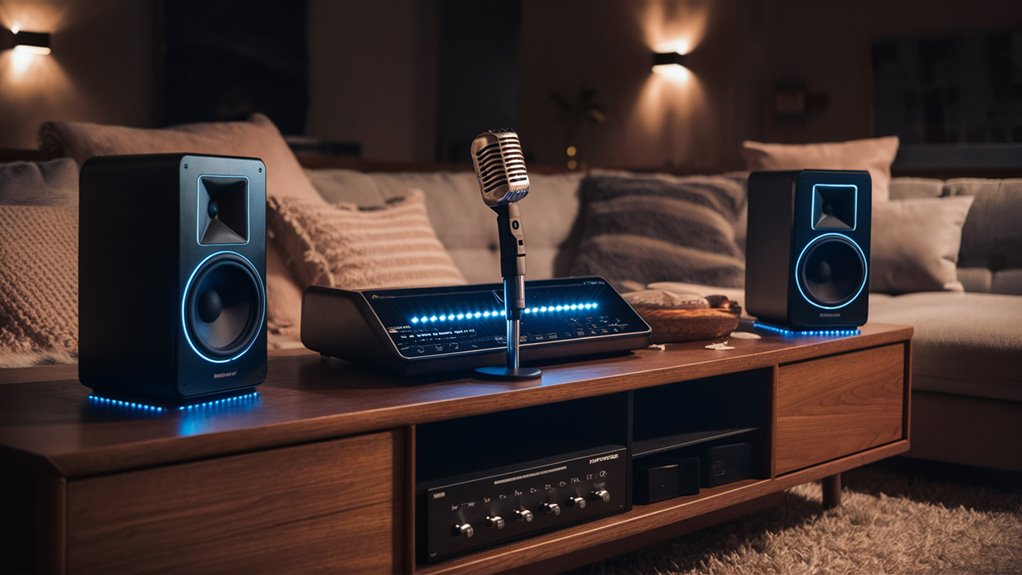
Top Karaoke Kits for Home Fun Nights
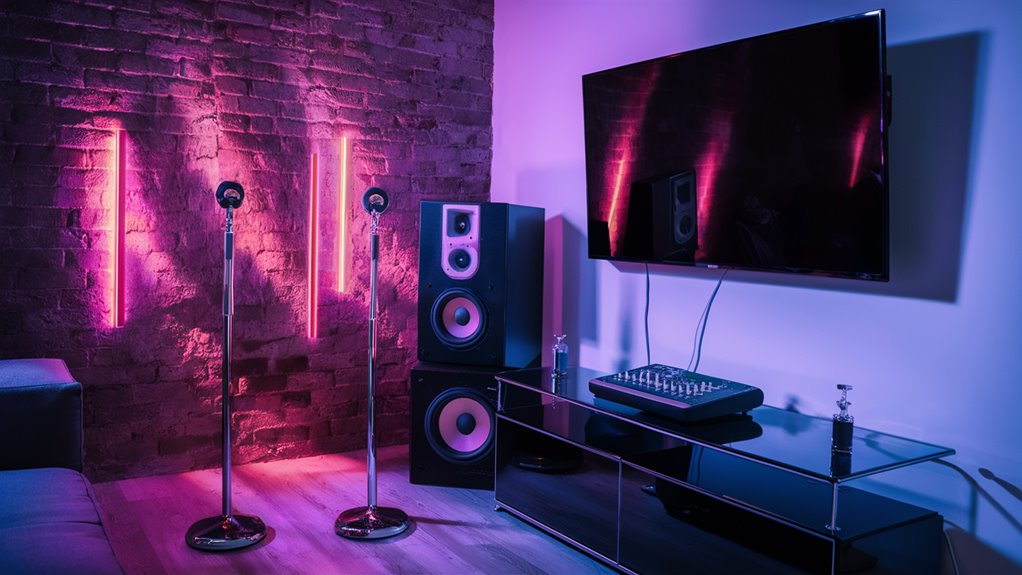
Key Gear to Have
The best home karaoke rigs need top-notch sound work and strong gear specs. A high-end system has 100W RMS per channel and 24-bit/192kHz sound work for very clear sound. Two XLR/1/4″ inputs and each has its own sound control are key for good sound mixing. 추가 자료 확인하기
Pro Sound Needs
Wireless mics that use the 500-900MHz UHF band give you clear voice and top sound. For the best sound shape, place speakers at ear level with 6-8 feet between them and keep them 2 feet from walls. Gear like the Singtrix Party Bundle brings cool things like 4-part harmony and sound fix tech.
Gear Ideas by Cash Limits
Top-tier Gear
High-end rigs, with 10-inch woofers and sound push tech, are tops for groups of 20-30. They give live-show sound with top sound work.
Start-Up Picks
Low-cost choices start at $200 have basic 16-bit sound work and needed stuff for small groups. These give good worth for easy karaoke fun.
Mid-Priced Options
Find a balance with rigs that have better sound work, many mic plugs, and built-in effects. These often have LCD screens and big song lists.
Guide to Best Home Karaoke Kits
Top-Grade Home Karaoke Gear
Pro singers and home fun fans can now get studio-grade karaoke kits for home use.
The Singtrix Party Bundle Premium gives great performance with its smart effects maker and deep harmony tech. It links easy with phones and has smart voice boost tech for real-time sound fixes.
Classic Karaoke Gear Bits
The Karaoke USA GF844 is top of the line for classic karaoke bits, with a 7-inch color screen and two pro wireless mics.
This strong gear pumps 35 watts through built-in speakers while linking with outside sound systems via RCA. It records straight to USB, working with MP3+G files for lots of songs.
Top Sound Quality
The JBL PartyBox 1000 sets new marks in home karaoke sound quality with a big 1,100-watt power and clever three-way sound work.
This comes with pro DJ pad controls, fun light shows, and two mic plugs with their own sound controls. The smart Bluetooth lets you keep good sound over effects, with deep bass down to 40Hz getting all the sound of songs.
All You Need to Set Up a Karaoke Room
Best Sound Setup
Put your karaoke speakers at ear height turned 45 degrees to where you sing.
Keep them 2 feet from walls to cut unwanted echo.
Place speakers 6-8 feet apart for good sound across the room.
Space for Singing
You need a 8 x 10 foot area for free moving while you sing.
Set your screen at eye level, 4-6 feet from where you sing for easy seeing of words.
Put sound-soaking stuff like panels or heavy curtains on walls to cut echo and make sound better.
Lights and Keeping Wires Safe
Use soft LED lights above where you sing for a pro look but still enough light to see words.
Keep wires safe – stick all sound and power wires by walls or under covers to avoid trips and keep the signal strong.
Must-Have Karaoke System Bits: Full Guide
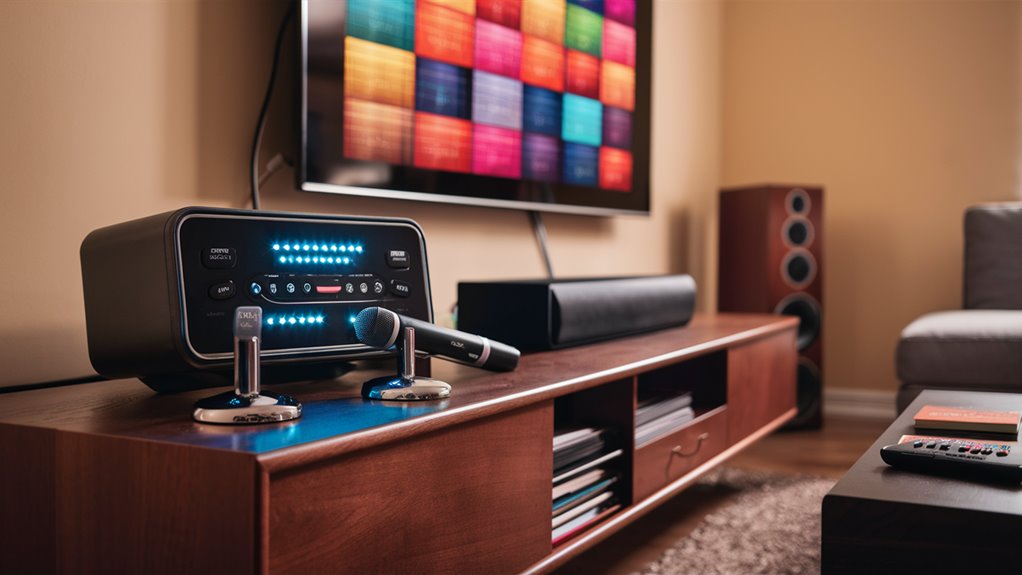
Main Audio Parts
Any great karaoke setup must have strong sound tools. A top mixer has two plug types with both XLR and 1/4″ inputs for using more than one device.
The setup must keep top sound quality through 16-bit/48kHz work and have smart DSP effects for better voice work.
Sound Push and Quality
Great sound output needs strong push, especially 100W RMS per channel. The sound range of 20Hz-20kHz makes sure all sounds are heard.
Systems with extra subwoofer outputs and adjustable sound crossing give better low sound control and space-filling sound.
Mic Tech
Great voice output needs UHF wireless mics working in the 500-900MHz area. Heart-shaped sound pick-ups and feedback cut tech make sure your voice is clear.
Having two mics lets you sing duets or with a group.
Digital Bits and Links
Modern karaoke fun systems need to support many file types like MP3, MP4, and CDG. Clear video on HDMI at 1080p gives sharp word displays.
Wireless link options through Bluetooth and extra storage via USB makes it easy to get to more content. Key voice control bits include each voice part’s volume control, echo change, and sound bending of up ±6 half-steps.
Pro vs Cheap Karaoke Kits: Full Look
Cash and Work Look
Pro karaoke systems have prices from $1,200 to over $5,000+, giving great worth with top DSP machines, high-end DACs, and smart voice boost bits.
These hit 24-bit/192kHz sound work, keep very low mess under 0.01% THD, and work with almost no wait below 3ms for studio-like performance.
Sound Quality Differences
Cheap karaoke kits starting at $200 use simple 16-bit sound work and Class-D push, showing clear sound cuts.
Sound range tests show big gaps: pro systems keep steady within ±0.5dB from 20Hz-20kHz, while cheap ones show ±3dB changes with big low sound cuts below 100Hz.
Pro Bits and Specs
Top mic preamps in pro systems use separate parts for better EIN rates under -128dBu.
Advanced bits include adjustable compression (1:1 to 20:1), adjustable EQ, and lots of feedback cuts with up to 12 notch filters.
Best Guide to Wireless Mic and Speaker Picks
Pro Wireless Mic Specs
When picking wireless mics, look for UHF systems in the 500-900 MHz range for best sound and low trouble.
Key parts include:
- At least 100-foot working area
- Sound range of 50 Hz to 15 kHz
- Below 10ms wait to stop echoes
- Rechargeable batteries with over 8 hours of use
- Auto sound scan ability
Speaker Must-Haves
Power and Bits
Choose powered PA systems with these must-have parts:
- 300+ watts RMS for 20-30 people
- 10-inch or bigger woofers
- 1.5-inch push tech The Best Songs That Will Show Off Your Vocal Skills at Karaoke
- Two-way speaker design
- Built-in sound crossers at 2.5 kHz
Key Speaker Parts
Top-grade speakers should have:
- XLR inputs for steady links
- Ground-lift switches for less noise
- Built-in EQ for feedback cut
- Two-way setup for even sound
- Strong build for longer use
The combo of UHF wireless mics and well-picked PA speakers gives clear voice, deep bass, and top-quality sound for any karaoke night.
